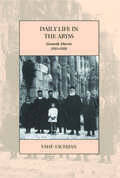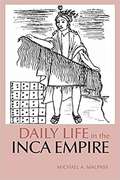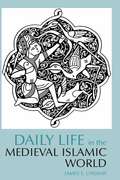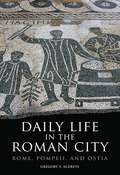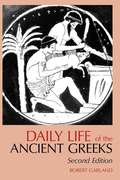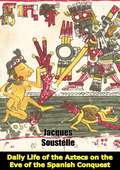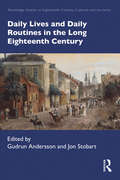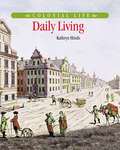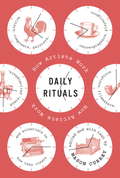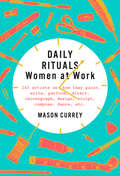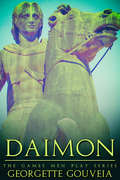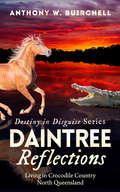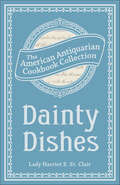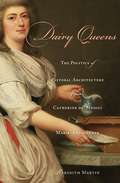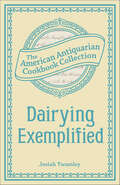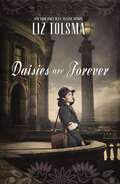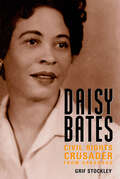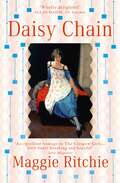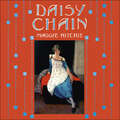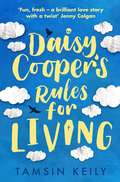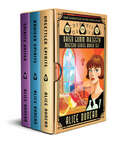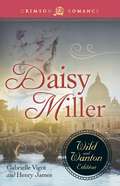- Table View
- List View
Daily Life in the Abyss: Genocide Diaries, 1915-1918 (War and Genocide #25)
by Vahé TachjianHistorical research into the Armenian Genocide has grown tremendously in recent years, but much of it has focused on large-scale questions related to Ottoman policy or the scope of the killing. Consequently, surprisingly little is known about the actual experiences of the genocide’s victims. Daily Life in the Abyss illuminates this aspect through the intertwined stories of two Armenian families who endured forced relocation and deprivation in and around modern-day Syria. Through analysis of diaries and other source material, it reconstructs the rhythms of daily life within an often bleak and hostile environment, in the face of a gradually disintegrating social fabric.
Daily Life in the Inca Empire
by Michael A. MalpassUnlike most studies of the Incas, this book reconstructs the daily life not only of the ruling Inca elite but also of the rest of the society, including the conquered peoples. From food and drink to religious rituals, the major aspects of life at all levels in the Inca empire are here described and explained in a clear, accessible way. <p><p>Over fifty illustrations are included, as are a historical timeline of the Inca empire, a glossary, and a bibliography.
Daily Life in the Medieval Islamic World
by James E. LindsayFrom the time of its birth in Mecca in the 7th century C.E., Islam and the Islamic world rapidly expanded outward, extending to Spain and West Africa in the west, and to Central Asia and the Indian Subcontinent in the east. An examination of the daily life in these Islamic regions provides insight into a civilized, powerful, and economically stable culture, where large metropolitan centers such as Damascus, Baghdad, and Cairo thrived in many areas, including intellectual and scientific inquiry. In contrast with medieval Europe, there is little common knowledge in the West of the culture and history of this vibrant world, as different from our own in terms of the political, religious, and social values it possessed, as it is similar in terms of the underlying human situation that supports such values. This book provides an intimate look into the daily life of the medieval Islamic world, and is thus an invaluable resource for students and general readers alike interested in understanding this world, so different, and yet so connected, to our own. Chapters include discussions of: the major themes of medieval Islamic history; Arabia, the world of Islamic origins; warfare and politics; the major cities of Damascus, Baghdad, and Cairo; religious rituals and worship; and a section on curious and entertaining information. Author James E. Lindsay further provides a focused look at the daily lives of urban Muslims during this time period, and of their interactions with Jews, Christians and other Muslims. Timelines, tables (including a calendar conversion to align the Islamic lunar and the Christian solar dates, and a dynastic table highlighting the major genealogies of the ancient ruling families), a bibliography, and a glossary of important dates and technical terms are also provided to assist the reader.
Daily Life in the Roman City: Rome, Pompeii, and Ostia
by Gregory AldreteAlthough most Romans lived outside urban centers, the core of Roman civilization lay in its cities. Throughout the empire these cities--modeled as they were after Rome--were strikingly alike. In Gregory Aldrete's exhaustive account, readers can peer into the inner workings of daily life in ancient Rome and examine the history, infrastructure, government, and economy of Rome; its emperors; and its inhabitants--their life and death, dangers and pleasures, entertainment, and religion. Aldrete also shows how Roman cities differed. To accomplish this comparison, in addition to Rome, he explores Ostia, an industrial port town, and Pompeii, the doomed playground of the rich. Daily Life in the Roman City includes a chronology, maps, numerous illustrations, useful appendices (on names, the Roman calendar, clothing and appearance, and construction techniques), a bibliography, and an index. This volume is ideal for high school and college students and for others wishing to examine the realities of life in ancient Rome.
Daily Life of the Ancient Greeks
by Robert GarlandSignificantly expanded and updated in light of the most recent scholarship, the second edition of Garland's engaging introduction to ancient Greek society brings this world vividly to life--and, in doing so, explores the perspectives and morals of typical ancient Greek citizens across a wide range of societal levels. Food and drink, literacy, the plight of the elderly, the treatment of slaves, and many more aspects of daily life in ancient Greece also come into sharp focus. More than sixty illustrations are included, as are maps, a chronology, a glossary of Greek terms, and suggestions for further reading.
Daily Life of the Aztecs on the Eve of the Spanish Conquest
by Patrick O’brian Jacques SoustelleTireless speech-makers and lovers of verse, the ancient Aztecs were also prodigious record keepers, using a pictographic system to keep records of their history, geography, and rituals. Many of these accounts were destroyed after the Spanish conquest; but fortunately, a few survived, including those kept by the invaders.This book by an international authority on Mexican archaeology and sociology presents a vivid history of that profoundly religious Aztec warrior society--from its days as a primitive people, to the early sixteenth century--when, on the eve of the Spanish conquest, a powerful native government ruled with great organizational ability and restless energy.Rare illustrations of the temples at Tenochtitlán and Tenayuca, human sacrifice, Aztec gods, weddings, the midnight revels of warriors, and many other subjects accompany a highly readable text that describes the problems of living in a great city-state, the ruling classes and living standards, religious beliefs, and the everyday lives of people. Here also are detailed descriptions of public buildings and market places, home furnishings, games and amusements, family life, the conduct of war, the arts of language, music and dancing, and other topics.Amazing in scope and detail, this work will be invaluable to students of Mexican history and of interest to anyone fascinated by this ancient civilization."Soustelle's great book about the Aztecs...takes us deep into the life of this great society..[His] book is one of the best ever written about the Aztecs, his portrait of their society is a triumph of scholarship, understanding, and literary skill."--The Times Literary Supplement"Probably the best general summary available of Aztec culture, both for the general reader and for the student."--Pedro Carrasco, Hispanic American Historical Review
Daily Life of the Aztecs: People of the Sun and Earth (The Daily Life Through History Series)
by Scott Sessions David CarrascoBased on the most recent archaeological discoveries, this volume offers a balanced interpretation of the complex relationships between Aztec cultural practices, social order, and religious myths and symbols. In addition to examining such topics as the ancient Aztec calendar, commerce, art, and human sacrifice, Carrasco considers the impact and influence Aztec culture continues to have on modern Mexican society. Heavily illustrated, this book also includes a chronology of Central Mexico, a glossary, and a selected bibliography.
Daily Lives and Daily Routines in the Long Eighteenth Century (Routledge Studies in Eighteenth-Century Cultures and Societies)
by Gudrun Andersson; Jon StobartThis book explores the ways in which the lives and routines of a wide range of people across different parts of Europe and the wider world were structured and played out through everyday practices. It focuses on the detail of individual lives and how these were shaped by spaces and places, by movement and material culture – both the buildings they occupied and the objects they used in their everyday lives. Drawing on original research by a range of established and emerging scholars, each chapter peers into the lives of people from various social groups as they went about their daily lives, from citizens on the streets to aristocrats at home in their country houses, and from the urban elite at leisure to seamen on board ships bound for the East Indies. For all these people, daily routines were important in structuring their lives, giving them a rhythm that was knowable and meaningful in its temporal regularity, be that daily, weekly, or seasonal. So too were their everyday encounters and relationships with other people, within and beyond the home; these shaped their practices, movements, and identities and thus served to mould society in a broader sense.
Daily Living
by Kathryn HindsPresents a glimpse of everyday colonial life by examining the daily life on the settlements.
Daily Rituals: How Artists Work
by Mason CurreyFranz Kafka, frustrated with his living quarters and day job, wrote in a letter to Felice Bauer in 1912, "time is short, my strength is limited, the office is a horror, the apartment is noisy, and if a pleasant, straightforward life is not possible then one must try to wriggle through by subtle maneuvers." Kafka is one of 161 inspired--and inspiring--minds, among them, novelists, poets, playwrights, painters, philosophers, scientists, and mathematicians, who describe how they subtly maneuver the many (self-inflicted) obstacles and (self-imposed) daily rituals to get done the work they love to do, whether by waking early or staying up late; whether by self-medicating with doughnuts or bathing, drinking vast quantities of coffee, or taking long daily walks. Thomas Wolfe wrote standing up in the kitchen, the top of the refrigerator as his desk, dreamily fondling his "male configurations". . . Jean-Paul Sartre chewed on Corydrane tablets (a mix of amphetamine and aspirin), ingesting ten times the recommended dose each day . . . Descartes liked to linger in bed, his mind wandering in sleep through woods, gardens, and enchanted palaces where he experienced "every pleasure imaginable." Here are: Anthony Trollope, who demanded of himself that each morning he write three thousand words (250 words every fifteen minutes for three hours) before going off to his job at the postal service, which he kept for thirty-three years during the writing of more than two dozen books . . . Karl Marx . . . Woody Allen . . . Agatha Christie . . . George Balanchine, who did most of his work while ironing . . . Leo Tolstoy . . . Charles Dickens . . . Pablo Picasso . . . George Gershwin, who, said his brother Ira, worked for twelve hours a day from late morning to midnight, composing at the piano in pajamas, bathrobe, and slippers . . . Here also are the daily rituals of Charles Darwin, Andy Warhol, John Updike, Twyla Tharp, Benjamin Franklin, William Faulkner, Jane Austen, Anne Rice, and Igor Stravinsky (he was never able to compose unless he was sure no one could hear him and, when blocked, stood on his head to "clear the brain"). Brilliantly compiled and edited, and filled with detail and anecdote, Daily Rituals is irresistible, addictive, magically inspiring.
Daily Rituals: Women at Work
by Mason CurreyMore of Mason Currey's irresistible Daily Rituals, this time exploring the daily obstacles and rituals of women who are artists--painters, composers, sculptors, scientists, filmmakers, and performers. We see how these brilliant minds get to work, the choices they have to make: rebuffing convention, stealing (or secreting away) time from the pull of husbands, wives, children, obligations, in order to create their creations. From those who are the masters of their craft (Eudora Welty, Lynn Fontanne, Penelope Fitzgerald, Marie Curie) to those who were recognized in a burst of acclaim (Lorraine Hansberry, Zadie Smith) . . . from Clara Schumann and Shirley Jackson, carving out small amounts of time from family life, to Isadora Duncan and Agnes Martin, rejecting the demands of domesticity, Currey shows us the large and small (and abiding) choices these women made--and continue to make--for their art: Isak Dinesen, "I promised the Devil my soul, and in return he promised me that everything I was going to experience would be turned into tales," Dinesen subsisting on oysters and Champagne but also amphetamines, which gave her the overdrive she required . . . And the rituals (daily and otherwise) that guide these artists: Isabel Allende starting a new book only on January 8th . . . Hilary Mantel taking a shower to combat writers' block ("I am the cleanest person I know") . . . Tallulah Bankhead coping with her three phobias (hating to go to bed, hating to get up, and hating to be alone), which, could she "mute them," would make her life "as slick as a sonnet, but as dull as ditch water" . . . Lillian Hellman chain-smoking three packs of cigarettes and drinking twenty cups of coffee a day--and, after milking the cow and cleaning the barn, writing out of "elation, depression, hope" ("That is the exact order. Hope sets in toward nightfall. That's when you tell yourself that you're going to be better the next time, so help you God.") . . . Diane Arbus, doing what "gnaws at" her . . . Colette, locked in her writing room by her first husband, Henry Gauthier-Villars (nom de plume: Willy) and not being "let out" until completing her daily quota (she wrote five pages a day and threw away the fifth). Colette later said, "A prison is one of the best workshops" . . . Jessye Norman disdaining routines or rituals of any kind, seeing them as "a crutch" . . . and Octavia Butler writing every day no matter what ("screw inspiration"). Germaine de Staël . . . Elizabeth Barrett Browning . . . George Eliot . . . Edith Wharton . . . Virginia Woolf . . . Edna Ferber . . . Doris Lessing . . . Pina Bausch . . . Frida Kahlo . . . Marguerite Duras . . . Helen Frankenthaler . . . Patti Smith, and 131 more--on their daily routines, superstitions, fears, eating (and drinking) habits, and other finely (and not so finely) calibrated rituals that help summon up willpower and self-discipline, keeping themselves afloat with optimism and fight, as they create (and avoid creating) their creations.
Daimon
by Georgette GouveiaHe was a romantic and a realist, a lover of strong women and beautiful men. And though he was at one time the richest, most powerful man in the world, his most prized possession was a book -- Homer’s The Iliad, annotated by his tutor, Aristotle.Most of all, he was as much a myth as a man and a mystery ... even to himself.When Alexander the Great died in Babylon in 323 B.C. a month shy of his 33rd birthday and after conquering and reordering Persia, he left a sprawling empire and a burning question: What drove him?Before Alexander, culture flowed East to West. After, it would flow West to East, and we are the heirs of the continuing tension between the two.In this historical novel, Alexander encounters the only two enemies he cannot defeat: death and time. Surrendering to both, he considers a life that attempted to bridge seemingly irreconcilable opposites -- East and West, Persians and Greeks, a brutal father and a ruthless mother, a wily wife and a male soulmate. And above all, a tempered mind and ungovernable passions.
Daintree Reflections
by Anthony W. BuirchellSuddenly there was an explosion in the centre of the billabong and a gigantic crocodile launched itself into the path of the incoming geese. The crocodile opened its massive jaws and seemed to hover in the air. The boys sat transfixed. Several magpie geese saw the danger and tried to swerve. The crocodile had selected one that was on a direct course to where its jaws would clamp shut around it. Black and white feathers flew in all directions and the crocodile's massive body whacked back into the water. Wave after wave rippled across the water and then all was still as if nothing had happened. "Jesus Christ," said Keith. "Did you see that?" Not only crocodiles but the ever present dangers of floods, wild pigs, cyclones, pythons, cassowaries, flash floods and taipans confronted the family daily. Did they all survive the years 1926 - 1936 as a family in the Daintree? Not only read about their quest for survival but also the fun and mischief they got up to.
Dainty Dishes
by Harriet St. ClairFrom her writing and recipe style, Lady Harriet was clearly a sophisticated woman of means who deplored the &“unpalatable horrible attempts at entrees, dignified with some high-sounding French name, made by the general run of English cooks.&” Her recipes for soups, sauces, fish, meat, poultry, vegetables and salads, eggs and cheese, pudding, jellies, pastries, bread, biscuits, cakes, liqueurs, pickling, coffee, and dairy making were clearly designed to replace the &“sodden pieces of meat, soaking in a mess of flour and butter . . . which forms the English cook&’s universal idea of a sauce, and which they liberally and indiscriminately bestow on fish, flesh and fowl.&” Refined and sophisticated, her cuisine was clearly targeted for those who appreciated and could afford good living. The last ten pages of the book contain a listing of other books published by Edmonston & Douglas of Edinburgh, so it is likely that the Philadelphia publisher J.B. Lippincott and Co. simply reprinted the original Engish edition in its entirety. This edition of Dainty Dishes was reproduced by permission from the volume in the collection of the American Antiquarian Society, Worcester, Massachusetts. Founded in 1812 by Isaiah Thomas, a Revolutionary War patriot and successful printer and publisher, the Society is a research library documenting the life of Americans from the colonial era through 1876. The Society collects, preserves, and makes available as complete a record as possible of the printed materials from the early American experience. The cookbook collection includes approximately 1,100 volumes.
Dairy Queens: The Politics of Pastoral Architecture from Catherine de' Medici to Marie-Antoinette
by Meredith MartinThese garden structures―most famously the faux-rustic, white marble dairy built for Marie-Antoinette’s Hameau at Versailles―have long been dismissed as the trifling follies of a reckless elite. Martin challenges such assumptions and reveals the pivotal role that pleasure dairies played in cultural and political life, especially with respect to polarizing debates about nobility, femininity, and domesticity. Together with other forms of pastoral architecture such as model farms and hermitages, pleasure dairies were crucial arenas for elite women to exercise and experiment with identity and power.
Dairying Exemplified: Or, The Business of Cheesemaking
by Josiah TwamleyThe American edition of Twamley&’s book was reprinted from the second British printing, described as &“corrected and improved.&” The author had the advantage of his own thirty-years&’ experience in cheese making, but he also apparently consulted with dairywomen from several countries in compiling the most successful procedures for making excellent cheeses. Covering everything from grazing land to care of cows to techniques for making the best cheeses of all varieties, the book also includes special chapters on butter and which noxious plants to remove from grazing lands to avoid bad tasting cheese. This edition of Josiah Twamley&’s Dairying Exemplified, or The Business of Cheese-Making was reproduced by permission from the volume in the collection of the American Antiquarian Society, Worcester, Massachusetts. Founded in 1812 by Isaiah Thomas, a Revolutionary War patriot and successful printer and publisher, the Society is a research library documenting the life of Americans from the colonial era through 1876. The Society collects, preserves, and makes available as complete a record as possible of the printed materials from the early American experience. The cookbook collection includes approximately 1,100 volumes.
Daisies are Forever
by Liz TolsmaIn the final days of Nazi Germany, the strength of one woman&’s heart will determine the fate of a family.Prussia, 1945The fall of the Third Reich is imminent. As the merciless Red Army advances from the East, the German people of Prussia await the worst.Among them is twenty-year-old Gisela Cramer, an American living in Heiligenbeil with her cousin Ella and their ailing grandfather. When word arrives that the Russians will invade overnight, Ella urges Gisela to escape to Berlin—and take Ella&’s two small daughters with her.The journey is miserable and relentless. But when Gisela hears the British accent of a phony SS officer, she poses as his wife to keep him safe among the indignant German refugees. In the blink of an eye, Mitch Edwards and Gisela are Herr and Frau Josep Cramer.Through their tragic and difficult journey, the fabricated couple strives to protect Ella&’s daughters, hoping against hope for a reunion. But even as Gisela and Mitch develop feelings beyond the make–believe, the reality of war terrorizes their makeshift family.With the world at its darkest, and the lives of two children at stake, the counterfeit couple finds in each other a source of faith, hope, and the love they need to survive.&“Tolsma isn't afraid to detail the horrors of war as she depicts how tragedies can be obstacles to one's Christian beliefs.&” —Romantic Times, 4-star review&“[Daisies Are Forever] is a compelling and fast-paced tale about the atrocities and tremendous losses endured by those marked forever by World War II. Recommended for fans of Rosamunde and Robin Pilcher, Kate Morton, and historical romances.&” —Library Journal&“Excellent storytelling, accurate historical reporting and gritty, persevering characters make this WWII-era novel a must-read.&” —CBA Retailers + ResourcesIncludes Reading Group Guide
Daisy Bates: Civil Rights Crusader from Arkansas (Margaret Walker Alexander Series in African American Studies)
by Grif StockleyDaisy Bates (1914–1999) is renowned as the mentor of the Little Rock Nine, the first African Americans to attend Central High School in Little Rock, Arkansas. For guiding the Nine through one of the most tumultuous civil rights crises of the 1950s, she was selected as Woman of the Year in Education by the Associated Press in 1957 and was the only woman invited to speak at the Lincoln Memorial ceremony in the March on Washington in 1963. But her importance as a historical figure has been overlooked by scholars of the civil rights movement. Daisy Bates: Civil Rights Crusader from Arkansas chronicles her life and political advocacy before, during, and well after the Central High School crisis. An orphan from the Arkansas mill town of Huttig, she eventually rose to the zenith of civil rights action. In 1952, she was elected president of the NAACP in Arkansas and traveled the country speaking on political issues. During the 1960s, she worked as a field organizer for presidents John F. Kennedy and Lyndon B. Johnson to get out the black vote. Even after a series of strokes, she continued to orchestrate self-help and economic initiatives in Arkansas. Using interviews, archival records, contemporary newspaper accounts, and other materials, author Grif Stockley reconstructs Bates's life and career, revealing her to be a complex, contrary leader of the civil rights movement. Ultimately, Daisy Bates paints a vivid portrait of an ardent, overlooked advocate of social justice.
Daisy Chain: a novel of The Glasgow Girls
by Maggie Ritchie'A wholly delightful novel' Allan Massie, ScotsmanLily Crawford and Jeanie Taylor, from very different backgrounds, are firm friends from their childhoods in Kirkcudbright. They share their ambitions for their futures, Lily to be an artist, Jeanie to be a dancer.The two women's eventful lives are intertwined. In the years before the First World War, the girls lose touch when Jeanie runs away from home and joins a dance company, while Lily attends The Mack, Glasgow's famous school of art designed by Charles Rennie Mackintosh. A chance meeting reunites them and together they discover a Glasgow at the height of its wealth and power as the Second City of the Empire - and a city of poverty and overcrowding. Separated once again after the war, Lily and Jeanie find themselves on opposite sides of the world. Lily follows her husband to Shanghai while Jeanie's dance career brings her international fame. But the glamour and dissolution of 1920s Shanghai finally lead Lily into peril. Her only hope of survival lies with her old friend Jeanie, as the two women turn to desperate measures to free Lily from danger.Inspired by the eventful and colourful lives of the pioneering women artists The Glasgow Girls, particularly that of Eleanor Allen Moore, Daisy Chain is a story of independence, women's art, resilience and female friendship, set against the turbulent background of the early years of the 20th century.
Daisy Chain: a novel of The Glasgow Girls
by Maggie RitchieLily Crawford and Jeanie Taylor, from very different backgrounds, are firm friends from their childhoods in Kirkcudbright. They share their ambitions for their futures, Lily to be an artist, Jeanie to be a dancer.The two women's eventful lives are intertwined. In the years before the First World War, the girls lose touch when Jeanie runs away from home and joins a dance company, while Lily attends The Mack, Glasgow's famous school of art designed by Charles Rennie Mackintosh. A chance meeting reunites them and together they discover a Glasgow at the height of its wealth and power as the Second City of the Empire - and a city of poverty and overcrowding. Separated once again after the war, Lily and Jeanie find themselves on opposite sides of the world. Lily follows her husband to Shanghai while Jeanie's dance career brings her international fame. But the glamour and dissolution of 1920s Shanghai finally lead Lily into peril. Her only hope of survival lies with her old friend Jeanie, as the two women turn to desperate measures to free Lily from danger.Inspired by the eventful and colourful lives of the pioneering women artists The Glasgow Girls, particularly that of Eleanor Allen Moore, Daisy Chain is a story of independence, women's art, resilience and female friendship, set against the turbulent background of the early years of the 20th century.(P) 2021 Hodder & Stoughton Limited
Daisy Cooper's Rules for Living: 'Fun, fresh - a brilliant love story with a twist' Jenny Colgan
by Tamsin KeilyRule One: Anything Can Happen Daisy Cooper's life has been pretty uneventful - until the moment it suddenly ends. Unfortunately, her death is (literally) an accident: Daisy wasn't meant to die for another fifty years. One terrible, embarrassing clerical error is behind it - and Death himself is to blame. As Daisy battles against her new reality, she starts to learn that letting go isn't just a challenge faced by those left behind. And while she learns how to survive this impossible new reality, friendship, hope and even love begin to come alive in the most unexpected ways. For Daisy Cooper, death was the perfect time to start making sense of life... A fresh, funny and joyful story about our own humanity at the most testing times.
Daisy Gumm Majesty Mystery Series Boxed Set: Books 10-12 (A Daisy Gumm Majesty Mystery)
by Alice DuncanIn 1920s Pasadena, Daisy Gumm Majesty Faces Murder, Mayhem, and Misunderstandings in This Delightfully Twisty Three-Book Box Set of Cozy Mysteries with Heart, Humor, and a Hint of DangerUNSETTLED SPIRITS (Book 10): Murder at communion? Daisy Gumm Majesty didn’t see that coming—until her crystal ball said otherwise. Bootleggers, poison, and a killer’s hit list make this 1926 mystery unforgettably spirited.BRUISED SPIRITS (Book 11): When a battered bride needs saving, Daisy Gumm Majesty won’t rest—despite danger, deception, and high society’s disapproval. Justice takes guts, and Daisy’s got plenty in this gripping 1920s mystery.SPIRITS UNITED (Book 12): A dead librarian, a friend framed, and a library full of secrets—Daisy Gumm Majesty must untangle the clues before she’s silenced for good in this delightfully twisted 1920s mystery.AWARDS:Romantic Times Top Pick, Reviewer's Choice Awards, finalistAlice Duncan spent years avoiding what she knew she should be doing—writing—by professionally folk dancing instead. Eventually, her muse won the battle, and she’s been crafting engaging historical cozy mysteries ever since. Now a proud resident of Roswell, New Mexico, Alice enjoys the lack of smog and crowds while spoiling her beloved herd of wild dachshunds. Visit her at www.aliceduncan.net.Don’t miss a moment of the action with Daisy and her cadre of friends as they solve mysteries in 1920s Pasadena! Each story stands alone but is best enjoyed in order.1. Strong Spirits2. Fine Spirits3. High Spirits4. Hungry Spirits5. Genteel Spirits6. Ancient Spirits7. Spirits Revived8. Dark Spirits9. Spirits Onstage10. Unsettled Spirits11. Bruised Spirits12. Spirits United13. Spirits Unearthed14. Shaken Spirits15. Scarlet Spirits16. Exercised Spirits17. Wedded Spirits18. Domesticated Spirits19. Library Spirits20. Spirits Adopted21. Rosy Spirits
Daisy Miller
by Henry James Gabrielle VigotDaisy Miller will forever be a classic story of courtship. But the original novella is not a romance, per se, because the unrequited love of both of the two main characters, Daisy Miller and Frederick Winterbourne, longs for a happy and salaciously steamy conclusion. That's why modern author Gabrielle Vigot added a few key saucy scenes to enhance the relationship and sexual tension that is insinuated in Henry James's civilized original story.Daisy is a flirt and Winterbourne thinks he has her figured out. But little does he know that throughout his courtship, Daisy's attitude toward him is hardly that of the easy, swooning American girl he expected. Daisy makesWinterbourne's heart ache for her with her vampish teasing, confounds him deliciously, and infuriates him to the bitter end.Dear reader, you know you'll want to find out whether Daisy just simply loves to flirt with all of the impeccably dressed gentlemen of Rome, or whether she is partial to well-mannered but increasingly annoyed Winterbourne. Will Winterbourne's heart give up on her in the end, or will his feelings mature enough for him to claim her for himself once and for all?Daisy Miller was Henry James's most popular and controversial piece, and the original book printer sold 20,000 copies in a matter of weeks. Editor Geoffrey Moore preferred the fine writing in the original versions over thelater versions, and thus the purity of the first American version serves as the base for this Wild and Wanton edition.Sensuality Level: Sensual
Daisy Miller: The Wild And Wanton Edition
by Gabrielle VigotDaisy Miller will forever be a classic story of courtship. But the original novella is not a romance, per se, because the unrequited love of both of the two main characters, Daisy Miller and Frederick Winterbourne, longs for a happy and salaciously steamy conclusion. That's why modern author Gabrielle Vigot added a few key saucy scenes to enhance the relationship and sexual tension that is insinuated in Henry James's civilized original story.Daisy is a flirt and Winterbourne thinks he has her figured out. But little does he know that throughout his courtship, Daisy's attitude toward him is hardly that of the easy, swooning American girl he expected. Daisy makesWinterbourne's heart ache for her with her vampish teasing, confounds him deliciously, and infuriates him to the bitter end.Dear reader, you know you'll want to find out whether Daisy just simply loves to flirt with all of the impeccably dressed gentlemen of Rome, or whether she is partial to well-mannered but increasingly annoyed Winterbourne. Will Winterbourne's heart give up on her in the end, or will his feelings mature enough for him to claim her for himself once and for all?Daisy Miller was Henry James's most popular and controversial piece, and the original book printer sold 20,000 copies in a matter of weeks. Editor Geoffrey Moore preferred the fine writing in the original versions over thelater versions, and thus the purity of the first American version serves as the base for this Wild and Wanton edition.Sensuality Level: Sensual
Daisy Miller: The Wild and Wanton Edition
by Henry James Gabrielle VigotDaisy Miller will forever be a classic story of courtship. But the original novella is not a romance, per se, because the unrequited love of both of the two main characters, Daisy Miller and Frederick Winterbourne, longs for a happy and salaciously steamy conclusion. That's why modern author Gabrielle Vigot added a few key saucy scenes to enhance the relationship and sexual tension that is insinuated in Henry James's civilized original story.Daisy is a flirt and Winterbourne thinks he has her figured out. But little does he know that throughout his courtship, Daisy's attitude toward him is hardly that of the easy, swooning American girl he expected. Daisy makesWinterbourne's heart ache for her with her vampish teasing, confounds him deliciously, and infuriates him to the bitter end.Dear reader, you know you'll want to find out whether Daisy just simply loves to flirt with all of the impeccably dressed gentlemen of Rome, or whether she is partial to well-mannered but increasingly annoyed Winterbourne. Will Winterbourne's heart give up on her in the end, or will his feelings mature enough for him to claim her for himself once and for all?Daisy Miller was Henry James's most popular and controversial piece, and the original book printer sold 20,000 copies in a matter of weeks. Editor Geoffrey Moore preferred the fine writing in the original versions over thelater versions, and thus the purity of the first American version serves as the base for this Wild and Wanton edition.Sensuality Level: Sensual
